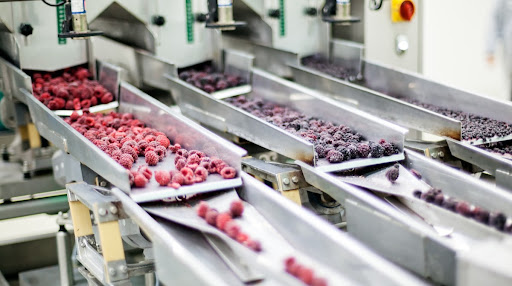
Food processing facilities may use much of the same equipment as other facilities, but their applications are often very different. HVAC systems, air compressors, and boilers can all be found in these facilities - but with an extra emphasis on cleanliness. Keeping people safe, and preventing contamination or spoilage on food products, has to be the highest priority. Cleanliness and low humidity are often the keys to a successful food processing facility.
Clean Air Is Key
When a facility is producing food, cleanliness must be paramount. Pathogens can contaminate food, rendering it unsafe to eat, unless clean air practices are strictly upheld. Pressurization and filtration are two of the most important parameters.
Pressurization
When the HVAC system for a food processing facility is designed, careful consideration must be given to the ductwork. If these lines become negatively pressurized, often from too many exhaust fans, unclean air can be pulled into the production area. By ensuring that the space stays pressurized, the clean air will instead spill out into other areas of the facility. Balancing these airflows to keep the production area slightly pressurized provides the benefits of pressurization without excessively increasing operating costs.
Related: The Impact of Your Equipment on IAQ
The pressurization of certain areas of the facility is accomplished by bringing in fresh, conditioned outdoor air to those spaces. An additional factor to keep in mind is the location of any outdoor air intakes for the HVAC system. If these intakes are located too close to something like an exhaust stack, the intakes may inadvertently pull in exhaust air instead of fresh clean air.
Filtration
Any air that enters the production area needs to be clean, high-quality air. Without proper filtration, contaminants can quickly spread throughout the entire production facility. The level of filtration required depends on the facility and the product being produced. MERV ratings correspond to the level of filtration a filter offers. The higher the MERV rating, the more effective the filter. The downside of high MERV ratings is how difficult it becomes to push air through these filters, which increases operating costs. Most filters for food production facilities will need to be at least MERV 8, often with a secondary MERV 14 or MERV 15 filter.
Related: Air Filter Applications
Compressed Air
Compressed air can have a variety of different uses in a food processing facility. Sometimes the compressed air will come into contact with the food and sometimes it won’t. The level of cleanliness and dryness in the air will depend on how that air is used in the facility. Some of the most common uses of compressed air inside a food production facility are:
- Peeling and Cutting Product
- Sorting and Moving Product
- Cooling Product
- Mixing Product
- Filling Pastries
Knives and blades get dirty. Clean, compressed air can often take the place of knives (such as when peeling onions or shelling nuts). Clean air is also a great way to move product through a facility and down a production line. Powdered product can even be pushed through tubes pneumatically, greatly reducing the number of moving parts and equipment that need to be cleaned.
Compressed air also provides a steady stream of air to cool down hot product fresh out of the oven or roaster. No matter how the compressed air is used in the facility, it must be sufficiently clean and sufficiently dry. Humid air can cause condensation on the food, which can be extremely dangerous and ruins the product.
Don’t Forget the Hot Water
Boilers are also often found in food production facilities. Hot water or steam can be used for a variety of reasons, typically cooking and sanitizing. Fryers and ovens in food production facilities will often get their heat from a steam boiler. Steam provides an efficient and consistent way to heat product.
Some food products can dry out during production. Steam humidifiers can help keep the humidity of the assembly line at a proper level. When using steam humidifiers, it is imperative that liquid water is not allowed to condense in the space or on the product.
Even when not being used to cook, steam and hot water are crucial for food safety within a food production facility. After shifts (or at other scheduled times), sanitization occurs to reduce the chance of any foodborne illnesses. All metal surfaces are sanitized, often with steam. Even the HVAC system ductwork and equipment is often sanitized with steam or washed out with hot water to keep the facility safe.
Although much of this equipment can be found in almost any facility, knowing what equipment your facility needs can seem like a daunting task. Tate has specialists ready to assist you and your food production facility with any equipment or maintenance needs you may have. Reach out today!
